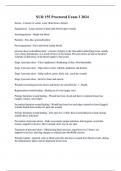NUR 155 Proctored Exam 3 2024
Serous - Consists of serum, water (fluid from a blister)
Sanguineous - Large amount of deep dark blood (open wound)
Serosanguineous - Bright red blood
Purulent - Puss like, greenish/yellow
Purosanguineous - Puss and blood (milky blood)
pressure ulcer or decubitus ulcer - consists of injury to the skin and/or underlying tissue, usually
over a bony prominence, as a result of force or movement. Pressure ulcers are due to localized
ischemia (a deficiency in the blood supply to the tissue).
Stage 1 pressure ulcer - Ulcer (epidermis). Reddening of skin. Non-blanchable.
Stage 2 pressure ulcer - Open ulcer (crater, reddish, epidermis and dermis)
Stage 3 pressure ulcer - Subq (yellow, green, beefy red... pack the wound)
Stage 4 pressure ulcer - Involves bone and muscle
Wounds (excluding pressure ulcers and burns) are classified by...? - Depth
Regeneration wound healing - Healing on it's own (paper cuts)
Primary Intention wound healing - Wound has been closed and there is minimal tissue loss
(staples, sutures, steri strips)
Secondary Intention wound healing - Would has tissue loss and edges cannot be closed (jagged.
wounds healed from inside out. pack the wound)
Tertiary Intention wound healing - Left open for a while, then closed (delayed wound closing,
usually due to infection)
Prevention of pressure ulcers - Daily assessment, proper nutrition, skin hygiene, avoid skin
trauma, supportive devices. Move around, don't stay in one spot.
Treatment of pressure ulcers - Minimizing direct pressure, reposition ever 2 hours, use
supportive devices, dressing changes as ordered, provide ROM exercise
Wound exudate - material, such as fluids and cells, that have escaped from blood vessels, during
the inflammatory phase and are deposited in/on tissue
, Cold on - acute
Heat on - chronic
Labs? - Hemoglobin level below normal can indicate poor oxygen delivery to the tissues. Serum
Albumin. Wound cultures.
Diagnoses - Risk for impaired skin integrity. Impaired skin integrity (involves the epidermis
and/or dermis). Impaired tissue integrity (damage to mucous membrane, or subq tissues). Risk
for infection. Acute pain.
S/S of Hypoxemia - nasal flare, diaphoresis, increased vital signs
S/S of chronic Hypoxemia - pale finger/toe tips and clubbed fingers
Assessment for circulation - vital signs, heart sounds, cap refill, pulses, color, warmth, edema
Preventing Cardiovascular Problems - ROM, elevate legs, frequent position changes, SCDs
Modifiable risks - Lifestyle, diet, weight
Non Modifiable risks - race, sex, age, genetics
Lab values for heart issues - Hgb (o2), K+, Creatine Kinase (CK; Increased days after MI),
Troponin (increased during MI)
Respiratory centers? - medulla and pons in the brain stem control breathing
Eupnea - normal respiration. Is quiet, rhythmic, and effortless.
Apnea - absence of breathing
Dyspnea - short of air
hyperventilation that accompanies metabolic acidosis - Kussmaul's breathing
Marked rhythmic waxing and waning of respirations from very deep to very shallow with short
periods of apnea - Cheyne-Stokes respiration
Orthopnea - inability to breathe easily unless sitting up right or standing
Conditions that decrease cardiac output - Congestive heart failure and hypovolemia
Diagnostic studies for o2 - Pulmonary function tests, arterial blood gases, sputum specimens,
incentive spirometers




